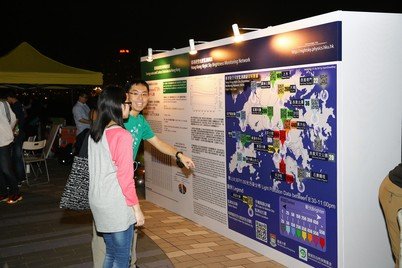Lifting the Veil on the Starry Sky
Hong Kong is one of the most light-polluted cities on Earth, a situation that not only blocks out the night but also represents a huge waste of energy. An astronomer at HKU has, fittingly, been at the forefront in calling attention to this problem.
Hong Kong is one of the most light-polluted cities on Earth, a situation that not only blocks out the night but also represents a huge waste of energy. An astronomer at HKU has, fittingly, been at the forefront in calling attention to this problem.
Dr Jason Pun, Principal Lecturer in the Department of Physics, began studying the brightness of Hong Kong's night skies in 2003 over concern about declining conditions and public indifference to the situation.
"When we first raised the idea of 'light pollution', the general sentiment of society was that Hong Kong was supposed to be bright and that this wasn't a problem," he said.
"But light pollution is a form of environmental degradation. Excessive artificial outdoor lightings, such as street lamps, neon signs and illuminated signboards, affect the natural environment and the ecosystem. Poorly designed outdoor lighting not only wastes energy, money and valuable resources, it also robs us of our beautiful night sky."
To set the matter right, Dr Pun and his team, including project manager So Chu-wing, began gathering information and getting it out to people to raise awareness.
Their efforts resulted in two funded projects to survey the night sky and provide hard data on the problem.
The first project, completed in 2009, involved taking about 2,000 individual readings at nearly 200 locations, with participation from such groups as local secondary schools. The results confirmed that the night sky was excessively bright.
The second project, completed in 2012, used automatic night sky measuring stations to provide long-term readings at 18 urban and rural locations. The researchers found the urban skies to be 33 times brighter than rural skies on average, supporting the contention that Hong Kong had one of the brightest night-time skies in the world.
The results received extensive media coverage and a website has been set up to continue providing the public with real-time readings from the measuring stations. Dr Pun also met with professional bodies and government officials to discuss the findings and possible mitigation measures.
Dr Pun said he and his team will continue to monitor night-time brightness so they can reveal long-term trends. They will also continue to beat the drum to raise awareness - an approach that is getting results. "I think the public is having second thoughts about some of those carved-in-stone ideas about Hong Kong's night sky," he said.
Dr Jason C S Pun received the Faculty Knowledge Exchange Award 2013 of the Faculty of Science for the 'Dimming the "Bright Pearl" - Informing the Public on Light Pollution' project.


